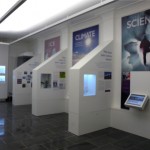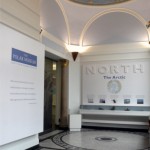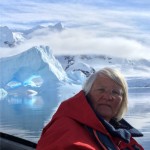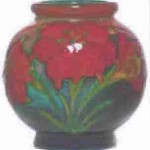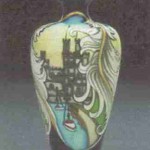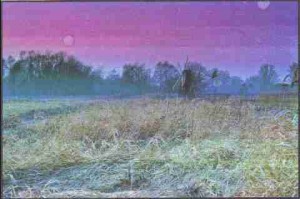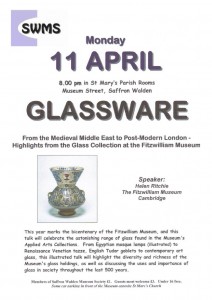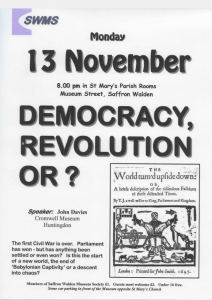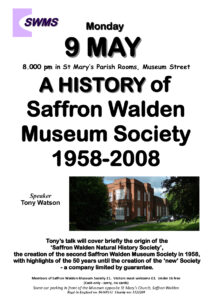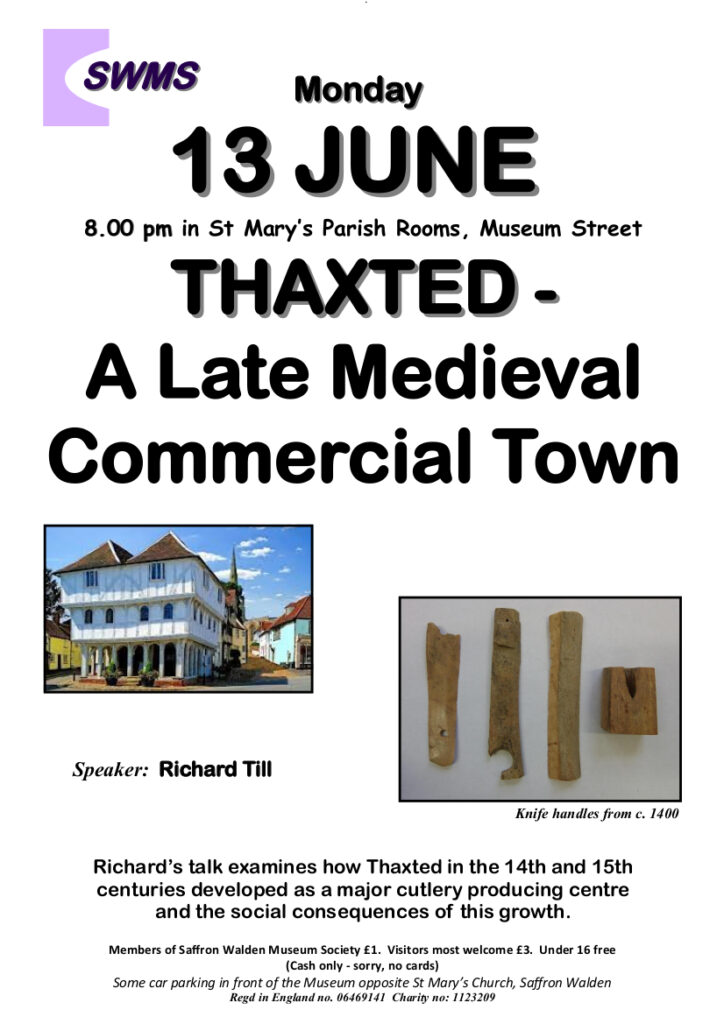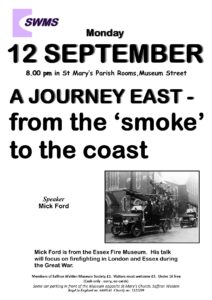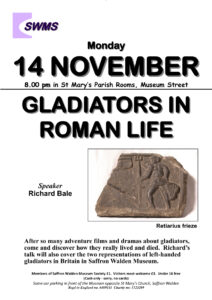Here we keep the collected advance notices of talks and events which previously appeared on this website but have already been held, as a reminder of the wide range of topics which have been covered. Society Members will be able to look at their Newsletters to see accounts of the talks and events which have been held, and the Newsletters are also archived on the Newsletter page of the website.
2015 archive
12th January 2015 – “Grunty Fen”
Speaker; Christopher South
The hilarious history of how Grunty Fen came to Little Chesterford.
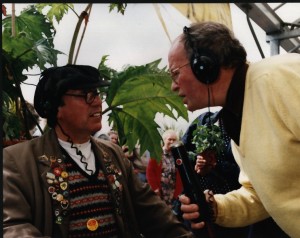 Each week for 17 years Christopher South sat at his kitchen table in Little Chesterford writing radio comedy scripts with Pete Sayers, the singer/songwriter who was Dennis of Grunty Fen.
Each week for 17 years Christopher South sat at his kitchen table in Little Chesterford writing radio comedy scripts with Pete Sayers, the singer/songwriter who was Dennis of Grunty Fen.
Before that, Christopher had been a serious journalist as columnist and news editor of the Cambridge Evening News and a presenter on BBC Radio Cambridgeshire where he still appears.
In a talk to the Museum Society he will tell how Grunty Fen has become a real place in the mental landscape of listeners all over the world and how he came to write the newly-published Guide Book to Grunty Fen, Gateway to the East. Christopher will also tell how some of the people he met as a teenage reporter in Saffron Walden became characters in the Dennis legend.
Monday 9th February
‘The Society for the Protection of Ancient Buildings and Our Local Heritage’
Speaker: Douglas Kent
BRIEF OUTLINE:
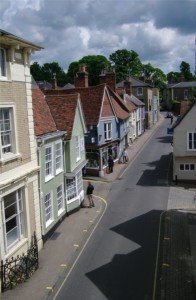 Douglas Kent will talk about the work of the Society for the Protection of Ancient Buildings (SPAB), properties in the town with which it has been involved over the years and his current award-winning renovation project at one of these, 25-27 Church Street (part of the old Sun Inn).
Douglas Kent will talk about the work of the Society for the Protection of Ancient Buildings (SPAB), properties in the town with which it has been involved over the years and his current award-winning renovation project at one of these, 25-27 Church Street (part of the old Sun Inn).
BIOGRAPHICAL NOTES:
The SPAB is the UK’s largest, oldest and most technically expert charity campaigning fighting to save old buildings from damage, decay and demolition. Douglas, a chartered surveyor, is its Technical and Research Director. He publishes and lectures regularly on building conservation and has contributed to various radio and television programmes. He also serves on many committees for organisations devoted to safeguarding our heritage and is chairman of the Hundred Parishes Society.
Monday, 9th March:
The Scott Polar Museum
Speaker: Heather Lane
Making a new museum – the redevelopment of the Polar Museum in Cambridge
This talk will examine the opportunities and challenges of developing a new museum from a little known research collection. The Polar Museum opened its doors in June 2010 to great public acclaim – find out what went on in the five years leading up to this point in the redesign and refurbishment of the galleries and stores, and what has happened since.
Heather Lane, M.A. (Oxon), DipLIS, MCLIP is the Keeper at the Scott Polar Research Institute, University of Cambridge.
She graduated from the University of Oxford and trained at the British Library. Her research interests include classification theory, particularly facet analytical theory. After obtaining a post-graduate qualification in Library and Information Studies in Aberystwyth, her professional career has been based in Cambridge, first at Gonville and Caius College and then as Librarian of Sidney Sussex College. Since 2004, she has been engaged in research into SPRI’s collections, with particular interests in the correspondence of
R.F. Scott, Inuit art and the photography of Ponting and Hurley. She led the HLF-funded project to renovate The Polar Museum, which reopened in June 2010 and is presently working on the Shackleton Project, to make the Institute’s collections fully accessible.
Monday, 13th April:
The Fry Gallery and its Collections, which include the Great Bardfield Artists
Speaker: Gordon Cummings
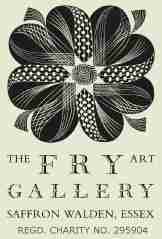
“I have been Hon. Secretary of the Fry Art Galley Society for more years than I care to remember. I am also the Honorary Treasurer of the Association of Independent Museums, who represent some 800 museums and galleries.
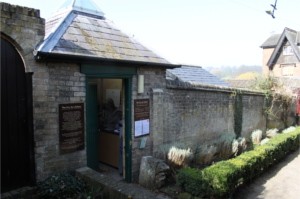 The Fry Art Gallery is now in its 30th year, and the Collection has grown to over 2,500 objects. Ours is a collection of works by north west Essex artists, and concentrates on the group who have come to be known as The Bardfield Artists. Their contribution to British art, particularly Edward Bawden and Eric Ravilious, is now becoming increasingly recognised.
The Fry Art Gallery is now in its 30th year, and the Collection has grown to over 2,500 objects. Ours is a collection of works by north west Essex artists, and concentrates on the group who have come to be known as The Bardfield Artists. Their contribution to British art, particularly Edward Bawden and Eric Ravilious, is now becoming increasingly recognised.
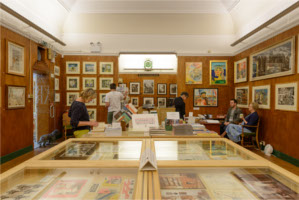 The Fry Gallery has, in effect, the national collection of Bardfield artists, and its reputation is now nation-wide. The heritage Lottery Fund recently awarded the Fry £200,000 to expand and improve our Collection.”
The Fry Gallery has, in effect, the national collection of Bardfield artists, and its reputation is now nation-wide. The heritage Lottery Fund recently awarded the Fry £200,000 to expand and improve our Collection.”
Monday, 11th May:
English Saffron – the reintroduction of saffron growing to Saffron Walden
David Smale
‘English Saffron’, or ‘English Saffron – of our Saffron and the Dressing Thereof’, to echo the original work by William Harrison in his The Description of England.
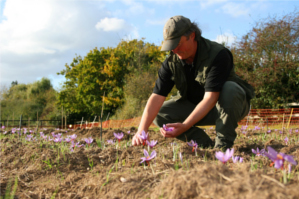 David Smale will give a brief history of saffron with a guide to the saffron crocus and its cultivation, together with the treatment of the harvested saffron and uses of saffron.
David Smale will give a brief history of saffron with a guide to the saffron crocus and its cultivation, together with the treatment of the harvested saffron and uses of saffron.
There will be a display of products from English Saffron
David is by training an Consulting Exploration Geophysicist and read Geology and Geophysics at Leicester University and Exploration Geophysics at Imperial College.
He began growing saffron about 12 years ago. Amongst other things he plays piano (ragtime), writes (screen and book), reads history and studies and writes about physics ( specifically superluminary investigations) and he travels wherever and whenever he can!
Monday, 8th June:
Sir Thomas Smith, scholar, statesman and son of Saffron Walden
Speaker: Rev. Jeremy Collingwood
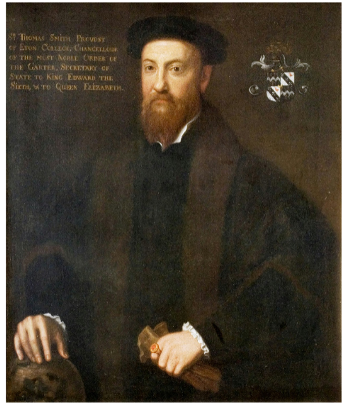 Sir Thomas Smith after relatively humble beginnings in Saffron Walden, rose to become one of the most powerful men in England, Secretary of State to two Tudor monarchs, and deeply enmeshed in many of the contentious issues of national politics in his time. This book is particularly timely, in focussing public awareness in Saffron Walden on the life and career of one of its most important sons, shortly before the 500th anniversary of his birth.
Sir Thomas Smith after relatively humble beginnings in Saffron Walden, rose to become one of the most powerful men in England, Secretary of State to two Tudor monarchs, and deeply enmeshed in many of the contentious issues of national politics in his time. This book is particularly timely, in focussing public awareness in Saffron Walden on the life and career of one of its most important sons, shortly before the 500th anniversary of his birth.
Jeremy Collingwood is a former lawyer, who has worked in Zambia and for the Director of Public Prosecutions in London. Following a second career in the Anglican ministry, he is now a retired minister living in Saffron Walden, where he pursues his passion for local history. This is his seventh book, others including Mr. Saffron Walden: the life and times of George Stacey Gibson 1818-1883.
SWHS Publications are sponsored by the Saffron Walden Historical Society, publishers of the Saffron Walden Historical Journal and aim to bring into the public domain work of original research relating to the history of Saffron Walden and north-west Essex.
ISBN – 978-1-873669-08-2 – £7.50
Books can be ordered from Saffron Walden Tourist Information
Sales Enquiries: tourism@saffronwalden.gov.uk
web page http://saffronwaldenhistory.org.uk/2013/07/29/sir-thomas-smith-scholar-statesman-and-son-of-saffron-walden/
Wednesday, 23 September 2015
Afternoon visit to Hill Hall,Theydon Mount, Epping, home of Sir Thomas Smith, Tour of the Hall at 2.00 pm. Car sharing.
Following Jeremy Collingwood’s talk about Sir Thomas Smith in June, we will visit his home, Hill Hall, Theydon Mount, Epping, Essex on Wednesday, 23 September 2015 for a guided tour at 2.00 pm. It is a fascinating building and to learn more about the details and difficulties associated with it, a personal visit is a must.
History of Hill Hall
The first known owner of the site was a Saxon called Godric and the first house was built in 13th century. It was Sir Thomas Smith who was largely responsible for rebuilding and remodelling the house in the 16th century. He was influenced by the classical architecture, that he had seen on his continental travels during the 1560’s and 1570’s. He superimposed Doric, Ionic & some Corinthian columns on some of the elevations and rebuilt the failing walls in a more robust manner and thoroughly “modernised” it. Internally he had some ambitious murals painted, some of which survive and are on view. It is a amazing building where much of the architecture & ornamentation was ahead of its time by several decades.
There was another rebuilding in the early part of the 18th century that include the north porch and the Humphrey Repton designs for the gardens. The building remained in the family until the early 20th century when it was purchased and lived in by a society hostess and then two other families. During WWII it had several roles but in 1947 was bought to be a women’s prison which opened in1952 and remained as such until it was largely gutted by fire in 1969 when the Department of the Environment took it over. English Heritage inherited it in 1984 and failing to find a buyer, carried out necessary repairs. Today most of the Hall is privately occupied but some parts remain accessible to the public by appointment.
We will also visit Theydon Mount Church for more information about the Smith family and where tea and cakes will be provided (£3 payable on the day). The tour of Hill Hall will take just over an hour while the tour of the Church will take around 45 minutes.
Monday, 14th September:
Wellington & Waterloo 1815
speaker ; Jef Page
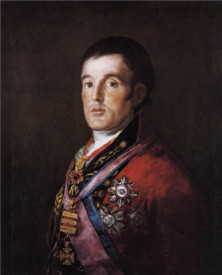
 The Battle of Waterloo was fought on Sunday, 18 June 1815, near Waterloo in present-day Belgium, then part of the United Kingdom of the Netherlands. A French army under the command of Napoleon was defeated by two of the armies of the Seventh Coalition: an Anglo-allied army under the command of the Duke of Wellington, and a Prussian army under the command of Marshal Blücher.
The Battle of Waterloo was fought on Sunday, 18 June 1815, near Waterloo in present-day Belgium, then part of the United Kingdom of the Netherlands. A French army under the command of Napoleon was defeated by two of the armies of the Seventh Coalition: an Anglo-allied army under the command of the Duke of Wellington, and a Prussian army under the command of Marshal Blücher.
Waterloo was a decisive battle as every generation in Europe up to the outbreak of the First World War looked back at Waterloo as the turning point that dictated the course of subsequent world history. However, Jef Page will describe the actual events of the battle and how victory over Napoleon, one of the greatest commanders and statesmen in history, was a close run thing.
Monday, 12th October:
Moorcroft Pottery
Speaker; Hugh Edwards, Chairman of Moorcroft Pottery.
Hugh Edwards is Chairman of Moorcroft Pottery whose passion for Moorcroft began as a law student.
Hugh will discuss Moorcroft’s history from William Moorcroft’s beginnings in 1897, through its control by Liberty – the famous London store – to his own involvement with the Moorcroft Company, and its current position as a world leader in art pottery.
Monday, 9th November:
Farming in the Fifties
Heather Salvidge and Dr. Carol Law
Ugley Hall Farm in the 1950s. The presentation by Heather Salvidge and Dr Carol Law will feature a film showing the farming year. Shot during the 1950s by the late Mrs. Reay, whose family farmed Ugley Hall Farm, a commentary has been added by Mrs Reay’s daughter, Jean.
2016 Archive
11 January 2016: Saffron Walden Photographic Archive
Speaker: Terry Ward, Local Historian
With over 5000 images of the town and surrounding villages have changed over the years Terry’s talk will discuss the reasoning behind the choice of subjects and the planning involved. He will also speak of the decisions relating to the sourcing and taking of pictures with historical content. Terry’s talk will be illustrated with many curated pictures from the archive.
Monday, 14th March: Wicken Fen
Speaker: Dr. Peter Green,
Eastern Region Speaker Panel, National Trust
Peter Green will cover a brief history of the formation of the Cambridgeshire fens and the great drainage project that started in the 17th century. He will explain how and why Wicken Fen avoided being drained, thus becoming an internationally important wetland nature reserve owned and managed by the National Trust. Peter will also describe how the fen is managed and what the plans for the future are.
Monday 11th April
Glassware
Speaker: Helen Ritchie, The Filzwilliam Museum, Cambridge
This year marks the bicentenary of the Filzwilliam Museum, and this talk will celebrate the astonishing range of glass featured in the Museum’s Applied Arts Collections, From Egyptian mosque lamps (illustrated) to Renaissance Venetian tazze, English Tudor goblets to contemporarty art glass, this illustrated talk will highlight the diversity and richness of the Museum’s glass heritage, as well as discussing the uses and importance of glass in society throughout the last 500 years.
Monday, 13th June:
Saint Mary’s Church, Saffron Walden
A tour of the church led by Rosanne Kirkpatrick at 8.00 p.m.
Rosanne Kirkpatrick will begin the tour of Saint Mary’s Church with a talk about the history of the Church and the people connected to its building. The tour of the Church itself will focus on particular items such as the brasses in the North Aisle, the Reverend John Lede’s tomb in the North Chapel and Lord Audley’s tomb in the South Chapel. She will also discuss the windows, the bells and textiles in the Church, such as the splendid kneelers and the banners that include Lord Butler’s Garter Banner.
Visit to Wicken Fen
Thursday, 30 June 2016
Wicken Fen is a wetland nature reserve situated near the village of Wicken in Cambridgeshire.
It is one of Britain’s oldest nature reserves, and was the first reserve cared for by the National Trust, starting in 1899. It is one of Europe’s most important wetlands and supports an abundance of wildlife. There are more than 8,500 species, including a spectacular array of plants, birds and dragonflies. There are also herds of free roaming Konik ponies and Highland cattle.
Our visit will include a guided walk, a boat trip along the Wicken Lode which is a lovely way to see the Fen and may include the possibility of seeing the Konik ponies and Highland cattle. There is also the fen-worker’s cottage and workshop to visit, as well as the Visitor’s Centre and shop. There is a cafe to have lunch.
Visit to Paycocke’s House, Coggeshall and Cressing Temple Barns
Wednesday, 24 August 2016
Eight miles to the east of Braintree lies Coggeshall, a lovely market town with an attractive centre made up of nearly 200 listed buildings. Many are timber-framed, dating as far back as the 14th century, including Paycockes House which is an exceptional example of a 16th century wealthy clothier’s house and also Grange Barn, founded in 1140, which is all that remains of the former abbey. Both properties are owned by the National Trust.
Cressing Temple Barns are four miles from Coggeshall. Cressing Temple was amongst the very earliest and largest of the possessions of the Knights Templar in England and is the location of three Grade 1 listed Medieval barns, one of which is the oldest standing timber framed barn in the world. Among the many gardens at the site, the Walled Garden is faithfully reconstructed as a Tudor pleasure garden, one of the few in the country. The Barns’ Tea Room is renowned for its lunches and its cream teas.
Our visit will include the morning free to visit Paycockes House and Grange Barn, both of which open at 11.00 am. There is limited roadside parking outside Paycocke’s House so it is best to park at Grange Barn (half a mile from Paycocke’s House) where tickets can be purchased to visit both Grange Barn and Paycocke’s House (if not a member of the National Trust). There is a coffee shop at Paycocke’s House.
In the afternoon there is a guided tour of Cressing Temple Barns at 2.00 pm that lasts approximately one and a half hours. Admission and parking at the site is free.
Monday, 12th September:
The Global in the Local
Speaker; Len Pole, former Curator of Saffron Walden Museum
Len’s talk will cover an overview of the range and significance of the many world cultures colelctions held by the smaller-scale non-national museums in the UK. This will be based on the surveys and work he has done in various museums over the past 30 years or so, as well as published sources. Len will also set out the special qualities of the world cultures collections in the Saffron Walden Musuem, not only in the context of others in this country, but internationally, also emphasising the local connections.
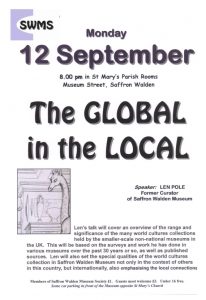
Monday, 10th October:
King Cnut and the Battle of Assandun – Where was it?
Speaker ; Patricia Croxton-Smith, Local History Recorder
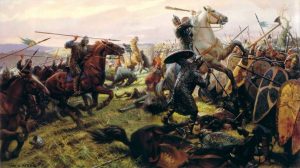
The Battle of Assandun was the last of five battles in the Viking campaign to take over England. The Anglo Saxons, led by Edmund Ironside, cut off the Vikings returning to their ships after they had been raiding in Mercia (the Midlands). They fought from nine in the morning until it was too dark to see clearly and “all the flower of the Angle kin was slain”. It ended in victory for the Vikings led by Cnut who shortly afterwards became King of all England. There is disagreement among historians as to where the battle took place. Patricia Croxton-Smith will argue that it did not take place in Ashingdon in southeast Essex and will present evidence that the Battle of Assandun took place in the area of the present-day parishes of Ashdon and Hadstock.

Monday 14th November
The History of Coggeshall Tambour Lace
Speaker: Sara Impey, Textile maker and Journalist
Coggeshall Tambour Lace, a type of hand embroidery on machine-made net, was a 19th Century craft unique to Coggeshall in Essex. Introduced in about 1820, it flourished as a cottage industry supplying wealthy clients in London, including Queen Adelaide (Wife of William IV ). The end of the century saw this form of lace making eclipsed by machine-made lace, although revivlas were seen several times during the 20th Century. Items were used by the royal family in the 1930s and exmaples were exhibited here and overseas. There are many examples in the V & A and local museums, including ours.
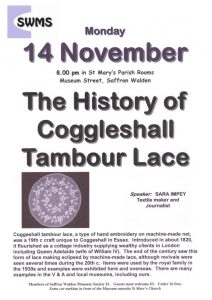
2017 ARCHIVE
9th January
The Place Names of Saffron Walden
Malcolm White, Local Historian and former Town Clerk

The 1758 map of Saffron Walden
Malcolm White, Local Historian and former Town Clerk, will give an illustrated talk on the place names of Saffron Walden, and how they reflect the shape, occupations, size, origins, and personalities of the town.
Monday, 13th February:
Printed Maps of Essex, 1576 to 1947: The Good, the Bad and the Downright Ugly
There have been hundreds of maps of Essex – but a lot of variations. What makes a map “Good” or “Bad”? What makes and “Ugly” map and why would one be made? Peter will use examples from his very wide collection of Essex maps from 1576 to 1947 to illustrate the Good, the Bad and the downright Ugly, as well as how county maps evolved over the centuries. His new book Printed Maps of Essex is now available.
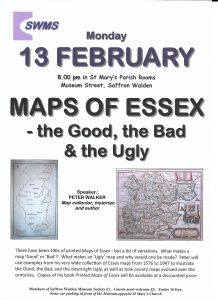
Peter Walker
Map collector, historian and author
Monday, 13th March:
Dressing Up: British portraits of the 18th century
Hugh Belsey
Lecturer and former Curator of Gainsborough’s House in Sudbury
Portrait painting was the staple of British painting and portraitists developed different ways to present their sitter’s apparel. Their dress was frequently simplified and sometimes updated, and the people of 18th century England were often shown in timeless fancy dress. Hugh’s talk will also refer to portrait paintings and the costume collection held at the Museum.
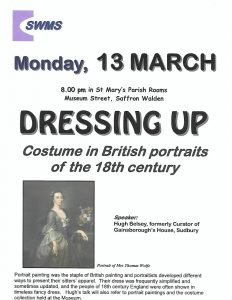
Monday, 10th April:
Darwin’s Life in Letters
Speaker: Sally Stafford
Education Outreach Officer,Darwin Correspondence Project,Cambridge University Library
The Darwin Correspondence Project is an independently-funded research team based at the Cambridge University Library. It locates and researches letters written by and to Charles Darwin (1809-1883). His letters are an essential resource for understanding the development of his ideas.
Sally Stafford’s talk is largely biographical but outlines how Darwin’s letters offer fascinating insights on his life, from his family relationships to his working methods. She will also highlight the natural history specimens brought back by Darwin from his Beagle voyage.
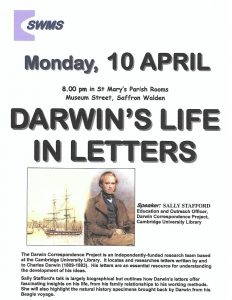
Monday, 8th May:
The Development of Palace House,Newmarket: the new National Heritage Centre for Horseracing
and Sporting Art
Speaker: Richard Fletcher
Community Volunteer Ambassador
The heritage of Newmarket and the racehorse have been linked since James I and his Court stopped in the town for hunting and hawking in 1604. Today. Newmarket is the undisputed ‘Headquarters’ of of flat racing with two reknowned racecourses which attract more than 350,000 racegoers, trainers, breeders and agents every year.
Richard’s illustrated talk is about the development of Palace House, Newmarket, built in the remains of King Charles II’s old palace and stables, and how it reflects the history of horse racing in Newmarket and the royal connections with the town.
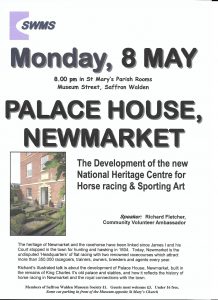
Monday, 12th June:
From Diamonds to Tin Cans: 300 years of jewellery design
Speaker: Helen Ritchie, Jewellery Historian, Fitzwilliam Museum, Cambridge
To complement Completing the Look: 300 year in Fashion Accessories at Saffron Walden Museum, jewellery historian Helen Ritchie will guide us through 300 years of jewellery design. From 18th century Rococo jewels, designs after the Neoclassical and Victorian novelties, to Arts & Crafts enamelling, Deco geometry and 21st century 3D-printing – this illustrated talk will link styles of jewellery to wider design trends as seen in fashion, furniture, architecture and interiors.
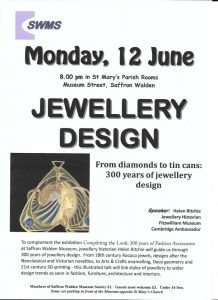
Monday, 11th September: The Ice Age in Essex and beyond
Speaker; Gerald Lucy, Fossil expert and author of “Essex Rocks”
About 450,000 years ago, in the middle of the Ice Age, almost the whole of Britain was buried beneath a giant ice sheet, in places over a mile thick. This was the coldest period of what we call the ‘Ice Age’, a remarkable period of the Earth’s recent history. Gerald Lucy will give an illustrated talk on the Ice Age in Britain and in Essex, and how it consisted of not just cold stages but also warm periods, some of which saw hippos wallowing in Essex rivers!
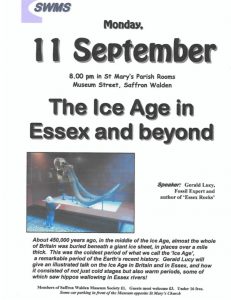
Monday, 9th October:
“The Lost Heroes of Bletchley Park or How Bill Tutte Won the War!”
Speaker: Richard Fletcher
Many thousands of people worked at Bletchley Park during World War II, but very few gained any public recognition. The talk concentrates on the work of Bill Tutte, whose achievements surpassed those of the famous Alan Turing but who remains largely unknown.
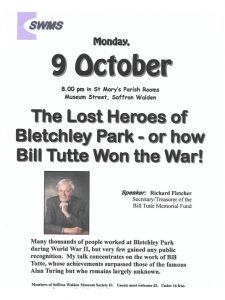
Monday, 13th November:
Oliver Cromwell
Speaker: John Davies, from the Cromwell Museum at Huntingdon
The first Civil War is over. Parliament has won but has anything been settled or even won? Is this the start of a new world, the end of “Babylonian Captivity” or a descent into chaos?
2018 Archive
Monday, 8th January
The buildings of the Palace of Westminster
Speaker: The Right Hon. Sir Alan Haselhurst
Monday, 12th February
20 Treasures from Saffron Walden Museum
Speaker: Carolyn Wingfield,
Curator of Saffron Walden Museum
An exploration of how the Treasure Act 1996 has added to the district’s archaeology collections, with a focus on some of the special finds acquired by the Museum over the past 20 years.
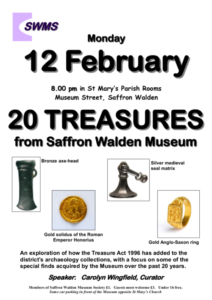
Monday, 9th April
The History of the Friends’ School
Speaker: Tony Watson, Chairman of Saffron Walden Museum Society
The Friends School has played an important role in the life of Saffron Walden and Tony Watson is well placed to tell us of the history as he experienced it as a pupil, and then as a Governor
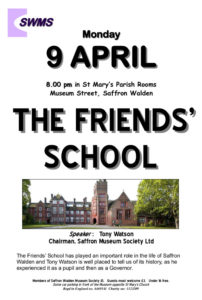
14 May
Ouse Fen: Building Britain’s Biggest Reedbed
Richard Taylor -Assistant Warden RSPB Ouse Washes
Reedbeds and the specialised animals and plants that inhabit them were once a
major component of the fenland landscape. Richard Taylor‘s talk will explain how
a partnership between the RSPB and Hanson Aggregates is creating a home for
bitterns, marsh harriers, bearded tits and other species, that will last for generations.
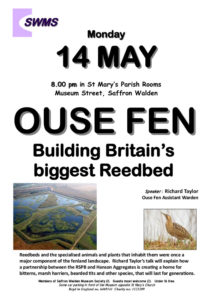
11 June
Happy Birthday to George Stacey Gibson – Aspects of his life and achievements
Jeremy Collingwood, Sarah Kenyon and Len Pole
Born 200 years ago, George Stacey Gibson had and still has a major
impact on Saffron Walden. Our speakers will be telling us about his life,
his contribution to the establishment and development of the Museum
and his work on natural history and geology.
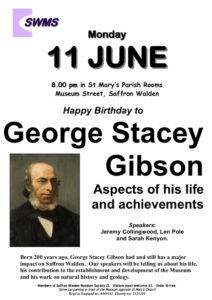
10 September
Worlds under Glass-Adventures in Taxidermy-
Speaker; Charlotte Pratt, Saffron Walden Museum, Learning and Outreach Officer and Curator of ‘Worlds Under Glass’ Exhibition at Saffron Walden Museum
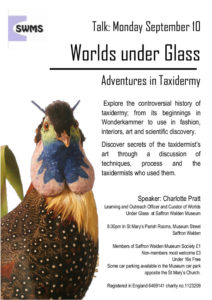
Explore the controversial history of taxidermy; from its beginnings in
Wonderkammer to use in fashion, interiors, art and scientific discovery.
Discover secrets of the taxidermist’s art through a discussion of
techniques, process and the taxidermists who used them.
8 October
The Queen of Chardonnay – Exciting Archeology at Chesterford
Speaker; Jacqui Hutton, Network Archeology
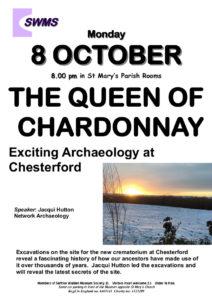 Excavations on the site of the new crematorium at Chesterford reveal a fascinating history of how our ancestors have made use of it over thousands of years. Jacqui Hutton led the excavations and will reveal the latest secrets of the site.
Excavations on the site of the new crematorium at Chesterford reveal a fascinating history of how our ancestors have made use of it over thousands of years. Jacqui Hutton led the excavations and will reveal the latest secrets of the site.
12 November
Tumult and Tears; The Story of the Great War through the Eyes and Lives of its Women Poets.
Speaker: Vivien Newman
This talk examines the poetry written by both serving and civilian women. This treasure trove of neglected poetry takes us to the heart of the Great War as seen through the eyes and lives of its women poets.
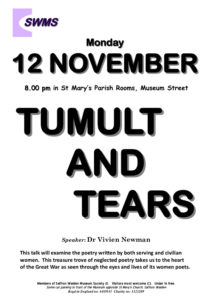
2019 Archive
14 January
Cambridge Science Festival- 25 Years of engaging the Public with Science.
Speaker : Dr Lucinda Spokes
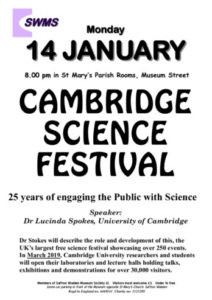
Dr Stokes will describe the role and development of this, the UK’s largest free science festival showcasing over 250 events in March 2019. Cambridge University researchers and students will open their laboratories and lecture halls holding talks exhibitions and demonstrations for over 30,000 visitors.
11 February
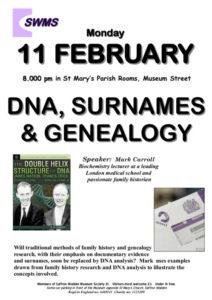
DNA, Surnames and Genealogy
Speaker: Mark Carroll
Biochemistry lecturer at a leading London medical school and passionate family historian
Will traditional methods of family history and genealogy research, with their emphasis on documentary evidence and surnames,soon be replaced by DNA analysis? Mark uses examples drawn from family history research and DNA analysis to illustrate the concepts involved.
11 March
The University Museum of Zoology Cambridge-Past, Present and Future.
Speakers ; Dr Roz Wade and Matt Lowe
The Talk discussed the history of the collection, which contains over 2 million items, the recent redevelopment of the Museum and the programme of education which the Museum runs
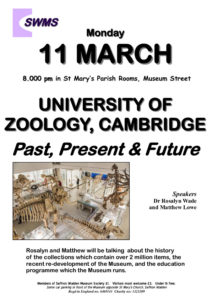
8 April
Essex Diary-the wildlife of Essex through the year.
Speaker : Liz Huxley
Using her own photography Liz Huxley discussed the many faces of Essex wildlife through the seasons.
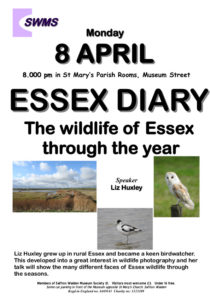
13 May
The Woman who Saved the Children
Speaker; Claire Mulley
Eglantyne Jebb, founder of Save the Children and pioneer of
children’s rights, was perhaps an unlikely children’s champion. In
1919, she launched Save the Children in London; 5 years later she
drafted the statement of children’s human rights, now evolved into
the UN Convention on the Rights of the Child.
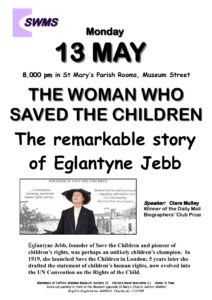
10 June
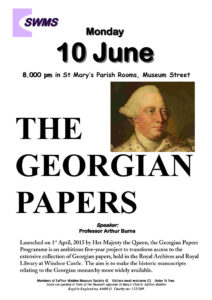
Launched on 1st April 2015 by Her Majesty the Queen, the Georgian Papers programme is a project to make the historic manuscripts relating to the Georgian Monarchy more widely available to the public by digitizing them! The Georgian Papers section of the Royal Archive comprises 425,000 items and were at the start of the project stored, uncatalogued, in cardboard boxes, unlabelled except for the few saying “miscellaneous”.
9 September
Taking away the Walls.
Speaker : James Lumbard Saffron Walden Museum

14 October
Church Graffiti.
Speaker: Anthea Hawdon
Since the churches of Essex were built, their parishioners and visitors have been leaving their marks on the walls. This talk covers the variety of graffiti found in churches, from medieval to World War 2, from gossip to magic and a lot of places in between. If you’re interested in a new source for local history research or how to keep evil spirits away, this talk has something for you!
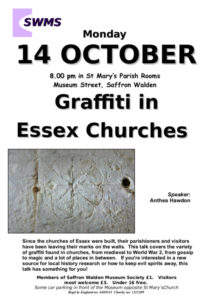
11 November
The Battle of Rorke’s Drift
Speaker : Paul Fairhurst
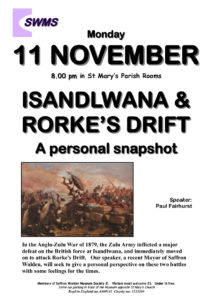
In the Anglo-Zulu War of 1879, the Zulu Army inflicted a major defeat on the British force at Isandlwana, and immediately moved on to attack Rorke’s Drift. Our speaker, a recent Mayor of Saffron Walden, will seek to give a personal perspective on these two battles with some feelings for the times.
2020 Archive
13 January 2020
The Essex Regiment during World War One.
Speaker: Peter Layzell
The Essex Regiment provided some 30 battalions to the British army in World War 1 and saw action in the Somme, Gallipoli, Egypt, and Palestine. Peter Layzell has made a long study of the Regiment’s achievements.
This talk by the manager of the Essex Regiment Family History Website is drawn from testimonies and newspaper accounts following the Regiment through the Great War including the soldiers daily routine, trench life and medical treatment.
10 February 2020
On Portraiture.
Speaker: Benjamin Sullivan
Our speaker is one of this country’s leading portrait painters. He will be talking about his work in the context of 20th century portraiture.
His work is to be found in numerous public and private collections, including the National Portrait Gallery, the Royal Scottish Academy, Parliament House, Edinburgh, and several Oxford and Cambridge Colleges.
9 March 2020
1,568 Sawdust Hearts
Speaker Tracey Fernandes
Soldiers wounded in the 1st World War were encouraged to decorate heart shaped bags filled with sawdust as a therapy. In 2018, a project to mark the centenary of that war was launched to provide one heart for each day of the War-hence 1568 Sawdust Hearts. 20 of these were made by volunteers in and around Saffron Walden and are now on display in the Museum. The speaker will tell us the full story.
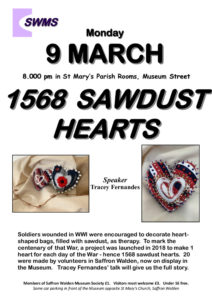
The programme of Talks was suspended during the COVID epidemic
Tuesday 13th October 2020
Bird Migration – a talk by Liz Huxley using Zoom
Liz opened her talk by describing the varieties of bird migrations; those of residents within the U.K., summer visitors, winter visitors, passage migrants, partial migrants and vagrants. Some will fly over water and others, where they can, use routes over land, some migrate by night – possibly using stars to navigate by – and some by day or, non-stop, by both. A highly detailed talk which was helpfully illustrated by charts and maps showing routes and areas of breeding etc. and pictures of birds.
2021 Archive – All talks held on ZOOM
18th January 2021
John Ray– Father of Natural History
Speaker: Jennifer Rowland
Via Zoom,
John Ray was a 17th century naturalist who was later dubbed the Father of Natural History. He was born in Black Notley, Essex on 29 November 1627 and died there on 17th January 1705.
8th February 2021
The Orphans of History : Market Towns from 1700
to the Present Day. Speaker: Tony Kirby
via Zoom
A talk illustrated with photos of, among others, the towns of Malton, his home town in Yorkshire, Royston, Lavenham, Ely, Wisbech, Haverhill, Downham Market, Hingham, St. Ives, and Saffron Walden.
8th March
Anglo-Saxon Rendlesham –
Speaker Faye Minter,
Senior Archaeological Officer with Suffolk County Council Archaeological Service
Via Zoom
A brief overview of the work of the S.C.C.A.S. which includes maintaining the Historic Environment Record for 40,000 plus sites in Suffolk. Since 2008 a series of investigations have taken place at Rendlesham at what is now known to be an important Royal Anglo-Saxon settlement, thought to be the largest and longest-lived site of its type.
10th May 2021
‘Latin Didn’t Kill Me – a wander round Pompeii’.
Speaker : Richard Priestly.
via Zoom
Pompeii was situated in the Bay of Naples, south-east of Vesuvius and 140 miles away from Rome. The nearby town of Herculaneum, a coastal resort, was to the south of Vesuvius. Originally Pompeii comprised five little settlements, founded in C8th BC by the Oscan people, then came Etruscans, Greeks, Sammites and, late first century BC, the Romans when Latin started to be spoken rather than Oscan. Today Pompeii’s ruins lie inland from the sea, then it was a coastal town, right up to the water’s edge, where our ‘wander’ started, at the Seagate
where moorings were attached to the sea wall.
19 April 2021
William Tompkins and the Landscapes of Audley End –
Speaker – Dr. Peter Moore, Curator of Collections and Interiors for English Heritage at Audley End and Wrest Park
A Zoom talk hosted by Richard Priestly
In 1763 Sir John Griffin Whitwell inherited the Audley End estate from his aunt, Elizabeth Griffin, Countess of Portsmouth. A condition of his inheritance was that he changed his surname to Griffin, so he did and subsequently became Sir John Griffin Griffin. He also like many in his position, commissioned ‘Capability’ Brown to lay out the grounds of Audley End, and Robert Adam to work on some aspects of the house – and to design the delightful bridge over the River Cam.
14 June 2021
THE SPY WHO LOVED – Talk by Clare Mulley about her book of this title –
via Zoom, hosted by Richard Priestly
This book is about the complicated life and lovers of the Polish-born, part Jewish, lapsed Roman Catholic, Countess Krystyna Skarbek who became known as Christine Granville, the name I shall use for this resumé. Born in 1908, hers was an intricate upbringing, comprising much complicated detail, as indeed did the rest of her life, especially during the war years 1939 -1945 when her name changed and she managed to ‘lose’ seven years from her age. She also had to use many false names during her career as a secret agent. She was married twice and divorced once after a short marriage , remarrying in 1938 a top Polish diplomat, some 20 years her senior. She was very attractive, audacious, incredibly brave, inventive, an excellent skier and an astonishingly effective secret agent who saved the lives of many of her male colleagues. She also had many lovers and it was the last of these who murdered her in London in 1952.
Mon. 13 Sept 2021 – The Secret Life of a Wood –
a talk by Roger Hance
By Zoom hosted by Richard Priestley
If, when you go for a woodland walk, you simply enjoy the stroll along woodland ways and look up at ‘the trees’ and just enjoy more sunlit areas and are not too aware about the seasonal changes, then Roger’s talk about the birds, mammals, insects, wild flowers, fungi and other inhabitants will give you a great deal more to interest you in future. It was a great help that he is also an award-winning photographer whose photos illustrated the subjects he talked about.
October 11th 2021.
The Stort Story – Speaker, Richard Thomas
Zoom Host – Richard Priestley
This talk was about the story of the Stort Navigation which is 13 3⁄4 miles long, drops 92 feet and has 15 locks, but Richard Thomas started by tracing the Stort river’s source and early use.
8 November 2021
The World of Art Nouveau : Speaker Mark Lewis
Zoom host – Richard Priestley
The Art Nouveau aesthetic movement started around the end of the C19th, reacting to the then current high Victorian style, had its heyday during the first decade of the C20th and was virtually dead after the First World War. By then it had become perhaps too ornate and frivolous for the mood of Europe and it was also expensive. One of the significant influences threading through the Art Nouveau was the awareness of shapes and the forms of the natural world and its metals, stones and woods. Also, people were beginning to travel to Japan and encountered the forms, designs and colours of Japanese art providing inspiration in various ways and bringing back examples.
2022 Archive
10 January 2022
Children at War 1914 – 18
“What was done to us was wrong” Mary Manko
Speaker Dr. Vivien Newman
Zoom Host : Richard Priestly
the first talk of the year to hear about the roles and lives of children in WWI a variety of stories about some of the lives – and deaths – experienced by children in WW1. It was a time of deep ambiguity when side by side with excitement over jingoist stories was Man’s
inhumanity to Man.
15 February 2022
Murder, Sex and Mayhem in English Churches
A Talk by John Vigar via Zoom Hosted by Richard Priestly
14th March 2022
Thomas Cook and the Origins of Popular Tourism
Speaker – Paul Smith a Zoom talk; Host, Richard Priestley
This talk was about Thomas Cook and his original idea of organised day trips that became fully grown package holidays, and how the business was carried on by, first, his son and
then his three grandsons. This remarkable man, founder of popular tourism, with very little backing, came up with the thought of holidays with a purpose and which were also educational. He was born in 1808 in Melbourne, Derbyshire.One day in 1841, while walking from Market Harborough to a temperance meeting in Leicester, he had an idea; he would utilise the new railway network to take people on trips.
Monday 9 May 2022 – (A return to Live Talks)
The Saffron Walden Museum Society 1958-2008 – Speaker; Tony Watson
Monday 13 June 2022
Thaxted -A Late Medieval Commercial Town – Speaker; Richard Till
Monday 12 September 2022
“From the “Smoke” to the Coast,
Firefighting in London and Essex During the Two World Wars – by Mick Ford
Monday 10 October 2022
Cooking with Saffron – by Samantha Bilton
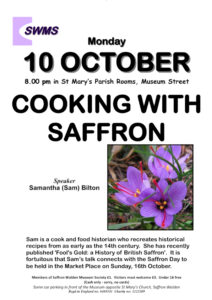 Sam is a writer, cook and food historian who has recently published ‘Fool’s Gold: a History of British Saffron’ who writes and broadcasts regularly and recreates historical recipes from as early as the 14th century. She will be at Hart’s Books to sign copies of her book on Saturday, 15 October.
Sam is a writer, cook and food historian who has recently published ‘Fool’s Gold: a History of British Saffron’ who writes and broadcasts regularly and recreates historical recipes from as early as the 14th century. She will be at Hart’s Books to sign copies of her book on Saturday, 15 October.
Sam will be explaining how saffron was used in cookery through the centuries when she takes part in ‘Saffron Day’ on Sunday, 16 October, to be held in the Market Place from 11.00am-4.00pm. This event celebrates the town’s historic association with saffron cultivation. There will be stalls selling saffron products, demonstrations of the use of saffron as a dye and talks on growing the saffron crocus as well as food and drink, music and entertainment.
Monday 14 November 2022
Gladiators in Roman Life – by Richard Bale








